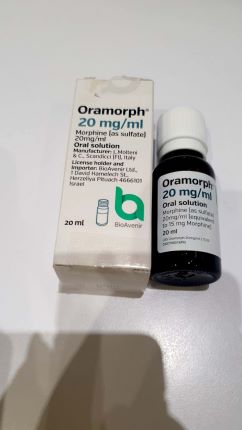Quest for the right Drug

אורמורפ 20 מ"ג / מ"ל ORAMORPH 20 MG/ML (MORPHINE AS SULFATE)
תרופה במרשם
תרופה בסל
נרקוטיקה
ציטוטוקסיקה
צורת מתן:
פומי : PER OS
צורת מינון:
תמיסה (פומי) : SOLUTION (ORAL)
עלון לרופא
מינוניםPosology התוויות
Indications תופעות לוואי
Adverse reactions התוויות נגד
Contraindications אינטראקציות
Interactions מינון יתר
Overdose הריון/הנקה
Pregnancy & Lactation אוכלוסיות מיוחדות
Special populations תכונות פרמקולוגיות
Pharmacological properties מידע רוקחי
Pharmaceutical particulars אזהרת שימוש
Special Warning עלון לרופא
Physicians Leaflet
Pharmacological properties : תכונות פרמקולוגיות
Pharmacodynamic Properties
5.1 Pharmacodynamic properties Pharmacotherapeutic group: Opioids ATC-code: N02A A01 Morphine is a phenanthrene alkaloid from Papaver somniferum with opioid-agonistic properties. It shows distinct affinity to µ-receptors. Central effects Morphine has analgesic, antitussive, sedative, tranquilising, and antidiuretic effects. It provokes respiratory depression and miosis. Emetic and antiemetic effects have been described, the latter occurring as a delayed effect, furthermore a slight decrease in blood pressure and heart rate was reported. Peripheral effects Constipation, contraction of the sphincters of the bile ducts, increase in tone of the urinary bladder muscles and the vesical sphincter, prolonged stomach passage effected by pylorus constriction, flushing, urticaria and pruritus due to the release of histamine, and in asthmatic patients bronchospasm, influence on the hypophyseal-hypothalamic axis and consequently influence on hormone effects of corticoids, sex hormones, prolactin and antidiuretic hormone. Manifestation of clinical symptoms due to these hormonal changes may be feasible. Onset of action after oral application is after 30-90 minutes. The duration of action lasts about 4- 6 hours and markedly longer in prolonged-release formulations. Onset of action after intramuscular or subcutaneous application is after 15-30 minutes, after intravenous application within a few minutes. Independent of these routes of administration the duration of action last about 4-6 hours. Following epidural and intrathecal application locally limited analgesic effects are evident after a few minutes. The duration of action lasts about 12 hours following epidural use and is even longer in case of intrathecal administration. In vitro as well as animal studies show different effects of opioids of natural origin such as morphine on components of the immune system. The clinical relevance of these findings is not known.
Pharmacokinetic Properties
5.2 Pharmacokinetic properties Following oral application morphine is absorbed fairly rapidly, primarily from the upper small intestine and to a minor extent also from the stomach. The low absolute bioavailability (20%- 40%) is attributed to an extensive first-pass effect. About 20-35% of morphine is bound to plasma proteins, primarily to the albumin fraction. After intravenous administration of 4-10 mg as a single dose the distribution volume of morphine is reported at 1.0 to 4.7 l/kg. High tissue concentrations are encountered in the liver, the kidneys, in the gastrointestinal tract and in muscles. Morphine crosses the blood brain barrier. Metabolism of morphine occurs primarily in the liver but also in bowel epithelium. The main step is the glucuronidation of the phenolic hydroxyl moiety effected by the hepatic UDP- glucuronyltransferase and N-demethylation. Main metabolites are morphine-3-glucuronide and to a minor extent morphine-6-glucuronide. Among other components sulphate conjugates and oxidative metabolites such as normorphine, morphine-N-oxide and a morphine derivative hydroxylised in position 2 are formed. The half- life of the glucuronides is markedly longer than that of morphine itself. Morphine-6-glucuronide is biologically active. A prolonged effect in patients with renal insufficiency may be attributable to this metabolite. Following oral and parenteral application, about 80% of the administered morphine is recovered in urine (10% of unchanged morphine, 4% of normorphine, and 65% as glucuronides with a ratio of 10:1 for morphine-3-glucuronide: morphine-6-glucuronide). The elimination half-life of morphine is subject to high interindividual variability. Following parenteral application it ranges from 1.7 to 4.5 hours on average, occasionally about 9 hours were reported. Approximately 10% of the morphine glucuronides are excreted via the bile with the faeces.

מסגרת הכללה בסל
התוויות הכלולות במסגרת הסל
| התוויה | תאריך הכללה | תחום קליני | Class Effect | מצב מחלה |
|---|---|---|---|---|
| MORPHINE | ||||
| HYDROMORPHONE | ||||
| For the relief of severe pain in cancer. |
שימוש לפי פנקס קופ''ח כללית 1994
לא צוין
תאריך הכללה מקורי בסל
לא צוין
הגבלות
לא צוין
מידע נוסף
